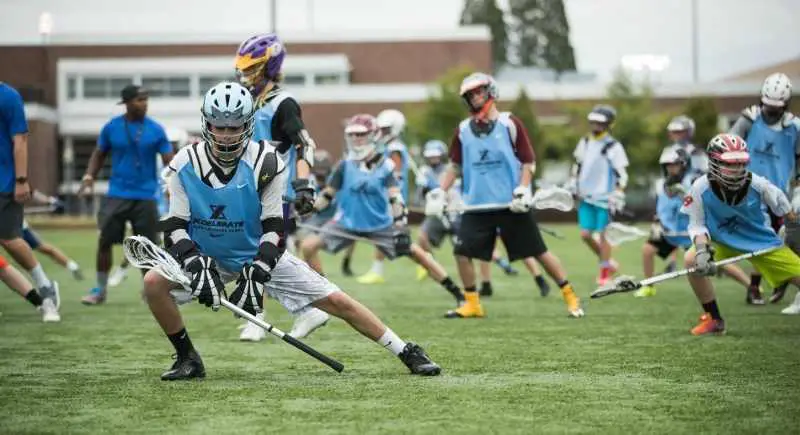Let me take a guess, you are feeling a bit unease or anxious as the lacrosse season is quickly approaching. Whether you are an experienced or beginner, there’s something about lacrosse tryouts that could make players feel nervous. To help you be prepared both physically and mentally as possible, read this post that helps you train for lacrosse tryouts and be ready with confidence and determination.
After all, “chance favors only the prepared mind.” Lacrosse tryouts are really an even playing field for everyone. As long as you come prepared, you will have a much better shot at impressing your coach and getting the most out of your practice time.
Without further ado, let’s get started.
Read also: Best Lacrosse Drills For One Person
What activities should you expect from lacrosse tryouts?
In a typical lacrosse tryout, there are a couple common and popular activities coaches utilize to gauge players’ ability. The goal of lacrosse tryouts is to choose the right players with the characteristics that make them great team players.
Coaches must use this short window of time to select the best players to play on the team. For this reason, coaches will test every aspect of a player to make the decision.

Thus, here’s what you should expect during lacrosse tryouts. Note this list is not exhaustive and should only serve as a reference.
- Warm Up
- Passing Line Drill
- Pass, Catch and Shoot
- Scooping Course
- Keep Away
- Wall Ball
- 4v3 Fast Break Drill
- 1v1 Dodging
- Scrimmage
Warm Up
Every lacrosse practice always starts with warm up. This is true across all sports tryouts. To start off, the whole team will run around the field for one lap at an average pace. After that, players will go to the sideline and transition into dynamic stretching. There are countless different stretching routines teams utilize and the goal of this session is to stretch and warm up your body.
So even if you encounter a stretching exercise you aren’t familiar with, follow your teammates and do the best you can to keep up the pace. No need to worry too much about this part of the tryout. Yet, take it seriously as warm up is meant for injury prevention.
Tips for a good warm up
Prepare yourself early so you arrive at the practice early. If there’s one thing beginners must remember is that the first impression starts before you enter the field. Coaches often pay attention to players who take tryouts seriously. This is the moment you can gain some points for yourself. Thus, get there early so that you are ready to go when warm up starts.
Secondly, as I mentioned earlier, warmup is not meant to be hard but it doesn’t mean it’s not important. Don’t goof around during warm up sessions. Giving yourself a good warm up not only prevents you from injuries but also lay a good foundation for intense activities later. So strongly recommend you take warm up seriously.

Lastly, remember every minute during tryouts counts. Some people might think I am exaggerating but it demonstrates your work ethic and determination, which is what coaches look for the most from players.
Read also: How to do lacrosse warm up
Passing Line Drill
Next up, we have a very common and basic passing drill you should expect during tryouts, the passing line drill. Since passing is a fundamental skill in lacrosse, this drill showcases each player’s ability around passing and catching. To make it more challenging, players should try to catch or pass using both hands.
So after warm up, players will break into three lines at three premarked positions. Each line will have another line that faces them directly toward them. Thus, there are in total three groups of players and six subgroups.
In each group, only one player has the ball. At the whistle, they pass the ball to the player directly facing them. Once the player delivers the pass, they will move towards the back of the line and wait till it’s their turn again. And the player who just receives the pass immediately passes to the next player that faces them. Throughout the drill, players should minimize the amount of cradling they do. It’s a quick series of receiving the ball and passing the ball.
Tips for a good passing line drill
This drill requires players to be able to catch and pass on the run. This is an extremely important skill as in a real game situation, you rarely remain stationary when playing lacrosse.
The best way to practice playing on the run is wall ball. Incorporate running into your wall ball routines. We will go in-depth on how to play wall ball shortly, so continue reading to see how you should play wall during practice.
Read also: How to catch in lacrosse
Pass, Catch and Shoot
This lacrosse drill is an upgrade from the passing line drill. It combines passing and shooting to test players’ accuracy and technique. We will use the same formation as in the previous drill where the starting player passes the ball to the shooting player who starts to jog toward the net. Once the shooting player catches the pass, s/he cradles for a few steps and then shoot on the net. After that, the players move toward the back of the line.
To make this more challenging, you can use a goalie to try to prevent the shooter from scoring to also test the goalie’s skill. Watch how this is done in a live demo:
Tips for a good pass, catch and shoot drill
Compared to the last drill, this one adds an additional complexity, specifically shooting on the run. Thus, in addition to practicing passing and shooting on the run, make sure you also get yourself used to shooting both stationary and on the run.
I wrote a post specifically on shooting in lacrosse, so check it out to improve and hone your shooting skills.
Read also: How to shoot in lacrosse
Scooping Course
After catching, passing and shooting, the next lacrosse skill players will get tested on is ground ball. Again players will stay in the same formation with three ground ball lines. This time instead of passing and catching, players will be rolling the ball out and scooping them inside the pockets
Another common ground ball exercise involves four or five cones in a zig-zag pattern, each about five yards apart. At each station, there will be a coach or player. At the whistle, the first on ball player runs to the first cone and scoops the ball from the ground while running. Once they got the ball, they will pass it back to the person by the cone. Then they will move on to the next station, where the person at the second station will roll the ball toward them to scoop and pass.
Tips for a good scooping course drill
Groundballs are absolutely crucial during a game. As long as you put in the effort, you can be great at it and coaches always love players who can scoop groundballs.
One key thing that separates great players from others is the fact that they are willing to get low and aren’t afraid of physical contact. Most players simply go through the motion without the willingness to actually fight for possession.
So to iterate, don’t be afraid to do the dirty work to win those ground balls. Being great at ground balls is a huge plus in every coach’s book.
Read also: How to scoop ground balls in lacrosse
Keep Away
The next common lacrosse drill you should expect is keep away. This drill tests the player’s ability to keep the ball and handle the ball under pressure. In this drill, instead of three lines of players, players will be divided into equally matched pairs.
After the drill starts, one player carries the ball while the other player tries to get it from him or her. They will switch roles either after the defender knocks the ball out of the other player’s stick or after a certain amount of time. This practice emulates an in-game situation where a player needs to protect the ball from the opponent.
This is also a great exercise to test defensive players’ footwork and positioning.

Tips for a good keep away
One advice I always give players to improve their ball retention is to work on their off-hand cradling. This is the best way to naturally create a barrier using your body between the opponent and the ball itself. Moreover, be quick on your feet, as long as you are quicker than your opponent on pacing, you are in control.
Check out this off-hand training post I wrote to help you improve your off-hand ability.
Wall Ball
Wall ball is the easiest and the best way to test players’ stick skills, so definitely expect to perform a wall ball test at some point during the tryout.
To begin, either the whole team or a few players at a time will get a spot in front of the wall and wait for coaches’ wall ball instructions. Then each player will need to perform a series of throws under a time limit.
The coach will have a timer in their hands to time how long players are taking to go through the repetitions. Thus, the best lacrosse players will be able to not only make accurate throws but also throw them as quickly as possible. You should aim to be the fastest.
Tips for a good wall ball session
If you have done enough practice in your spare time, this part of the tryout should feel easy. After all wall ball is every lacrosse player’s bread and butter. There are really no hidden secrets to it other than working on wall ball tirelessly. Invest in a rebounder and put it up in your backyard to start.
If you aren’t sure where to start and need some inspiration for different types of wall ball throws, I wrote a post on wall ball here. There are many different variations you could do, and the best way to improve is to emulate what professional players are doing.
4v3 Fast Break Drill
At this point, players have gone through extensive stick drills. It’s time to test players’ ability to play in more game-like situations. One of the most popular drills that resemble live gameplay is the 4v3 fast break drill.
This drill perfectly mimics a common in-game situation when the ball moves between the offensive and defensive fields. 4 offensive players will face up against 3 defensive players in these fast transitions. So this drill trains players on how to properly handle these very typical yet critical opportunities.
Inside the restraining box, there will be 3 offensive players being marked up by 3 opposing defenders. The goalie will be standing between the pipes. At the whistle, the fourth offensive player with the ball sprints down toward the goal and attempts to make a successful shot. Inversely, the defensive team tries to diffuse the threat and stall.
There are many great tutorials done by lacrosse coaches. Watch a walkthrough below:
Tips for a good 4v3 fast break drill
First, for beginners that have never done this drill before, this drill moves really fast. The coach will shout, “nice quick pass” throughout the drill. So you must get comfortable with throwing the ball in and out of the stick with a single cradle or two. To do this, we will go back to the good old wall ball practice again. Remember wall ball is your best friend when it comes to improving your stick skills.
In addition to being comfortable with quick passes, you need to know where to pass and how to create opportunities. In other words, building up your lacrosse IQ is also essential. In your spare time, watch some tutorials on fast breaks and game breakdowns to learn how to get good throwing passes.
1v1 Dodging
As the tryout comes to an end, one of the last few important drills players need to perform is dodging. For offensive players, dodging is the best way to rid of defensive pressure and create opportunities to threaten the goalie.
This drill is fairly simple. Each offensive player will be matched up against a defensive player. Depending on your position, players can dodge from four different corners of the field in this drill.
Tips to have a good 1v1 dodging
I also wrote a post on dodging that goes in-depth to help both offensive and defensive players to develop great dodging skills. As a beginner, the most important thing is to develop a toolkit of dodges at your disposal in a one-on-one matchup.
Scrimmage
Typically before the tryout ends, coaches will include scrimmages to evaluate both the player’s individual and the team levels. This is the best drill to allow coaches to test how players perform in game-like scenarios as well as how to build a team’s strategy.
Usually scrimmage will last anywhere between 10-15 minutes to give players enough time to showcase their abilities in every aspect of the game.

Tips to have a good scrimmage
For beginners, my best advice is to have a hustle mentality. Coaches love to see players with the willingness to improve and excel even if they aren’t the most skilled players. This means go fight for every ground ball opportunity and chase after fast breaks.
In addition, be a team player. Lacrosse is a team sport. The best lacrosse players understand they need to always put the team first. Doing things like passing to players who are in better positions will help you get noticed.
Conclusion
As we wrap up this post, give you one final advice which is to go have some fun! Tryouts could feel nerve-wracking but try to relax and have as much fun as possible. You will make some incredible friends during tryouts. It’s one of the best lacrosse memories I had believe it or not.
Use this post to prepare yourself. Although the actual program varies from team to team, I am confident you will be doing most of these activities. Be sure to report back after your tryouts!




